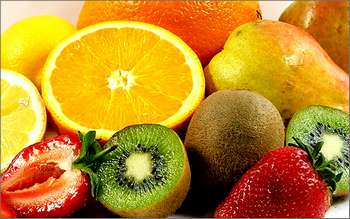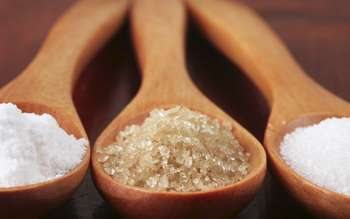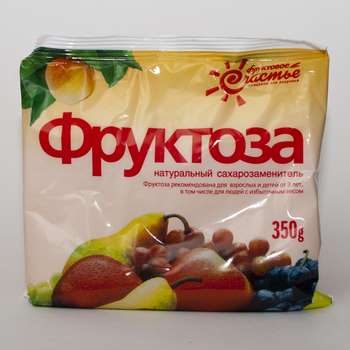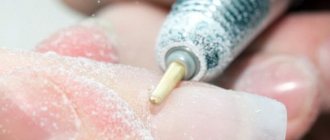Sugar and fructose: what is what
Before you understand whether you should give preference to fructose instead of sugar and whether it can replace regular granulated sugar when losing weight, you need to understand what these substances are.
You don’t need to think that regular table sugar is something chemical and unnatural. It is obtained mainly from sugar beets and sugar cane (very exotic sources for residents of our country are also possible, such as maple, palm or sorghum). It consists of the simple carbohydrate sucrose, which in the body is broken down into glucose and the same fructose in a ratio of approximately 50 to 50.
Fructose is an equally natural substance found in sweet fruits and honey, but in industrial conditions it is most often extracted... from the same refined sugar. Therefore, a beautiful juicy apple or any other juicy ripe fruit drawn on a package of fructose is, in the vast majority of cases, nothing more than a marketing ploy, a selling picture (much like photographs of actresses or fashion models who become the face of a particular cosmetic brand).
What is fructose
One of the most well-known natural sugar substitutes is fructose. This carbohydrate is found in honey, fruits and berries. It is from such raw materials that it is obtained in industrial quantities. The final product becomes a crystalline powder. It is actively used in the manufacture of sweet products. Today you can find a huge number of similar products on store shelves. Therefore, it is important to understand the characteristics of the substance, the possible benefits and harms of fructose, its use and effect on the body.
A little biochemistry
What happens to glucose and fructose in the body? Each of these substances is absorbed by him according to a strict scheme, and each has its own system.
Glucose absorbed by the digestive organs enters the liver. The body quickly recognizes this substance and decides in a short time what to do with it. If you have previously been actively involved in sports or performed physical work, and the level of glycogen in the muscles has noticeably decreased, then the liver will throw processed glucose to increase it.
If she herself needs support, she will save glucose for her own needs. But if you haven’t eaten anything for a long time and your blood sugar level has dropped noticeably, the liver will send glucose there. Another option is possible: when the body does not have any acute needs for glucose. In this case, the liver will send it to the fat depot, creating an energy reserve for future needs.
Fructose also ends up in the liver, but for it this substance is a dark horse. It’s unclear what to do with it, but it needs to be recycled somehow. And the liver sends it straight to fat stores, without consuming it even when the body really needs sugar replenishment.
This is why fructose is recommended for diabetics: being sweet, it does not end up in the blood, thereby not causing an increase in blood sugar levels and diabetic crises. But it immediately settles on the waist. This is why fruit sugar is not the best ally for losing weight.
Fructose instead of sugar when losing weight - what is the danger?
Since fructose provides fewer calories, it may seem like a great ingredient in a weight loss diet. Unfortunately, skipping the stage of insulin secretion into the blood after its consumption is not a uniquely positive aspect.
Surprisingly, 25% of people eat more than 130 grams of fructose per day. In fact, it enters the body in full from processed food. To make matters worse, all the fiber has been removed from these foods and they have virtually no nutritional value. And the very foods that most people rely on to lose weight often have the highest fructose content.
And the point is not that fructose itself is harmful - it is the massive doses to which the body is exposed that make it dangerous.
Researchers have found that by replacing just half of the glucose with fructose, the process of converting sugars into fat deposits (lipogenesis) increases significantly!
Fructose consumed at breakfast changes the way the body handles food from lunch. After taking fructose, the liver increases its supply of dinner fats, which could be used for other purposes.
It will be useful to know: How to replace sugar when losing weight - TOP 10 products
Fructose intake should be limited in the diet because it:
- increases LDL cholesterol levels, leading to fat accumulation around organs and heart disease;
- increases the level of uric acid, which reduces the content of nitric oxide, increasing the degree of angiotensin. Smooth muscle cells contract, raising blood pressure and potentially damaging the kidneys;
- leads to non-alcoholic hepatic steatosis, liver fibrosis or metabolic syndrome;
- damages the liver and provokes insulin resistance, which contributes to the development of type II diabetes;
- reduces activity in areas of the cerebral cortex;
- causes leptin resistance. Leptin is a hormone that controls appetite and metabolism to maintain normal weight. People with leptin resistance tend to gain excess weight and become obese;
- creates an imbalance of intestinal flora, promotes the proliferation and growth of pathogenic bacteria;
- High fructose intake leads to a host of age-related diseases such as atherosclerosis, erectile dysfunction, kidney disease, joint and skin stiffness, arthritis, cataracts, retinopathy, neuropathy, Alzheimer's disease and many others.
People who want to lose weight must strictly ensure that the daily intake of fructose does not exceed 25 grams.
What's good about fructose?

Fructose undoubtedly has many beneficial properties:
- it is absorbed very slowly in the intestines and quickly consumed by the body. In other words, if, when losing weight, you are not only on a low-calorie diet, but also exercise, then this sweetness can serve as an excellent source of energy for you, which will not provoke a rapid release of carbohydrates into the blood;
- the body does not need insulin to absorb fructose, this is another undoubted advantage for diabetics;
- the risk of developing caries when consuming such sugar is 40% less than when consuming regular refined sugar. This is due to the fact that the substances contained in glucose and deposited on the teeth as a yellow coating are very hard and strong, and it is not at all easy to break them. But fructose contains only weak compounds that are easily destroyed during regular brushing of teeth.
Fructose for diabetes
Diabetics have to clearly plan their diet and change their eating habits. Fructose serves as an excellent substitute for glucose and helps them diversify their diet. It was the industrial production of fructose that contributed to the emergence of a number of diabetic products. They allow you to eat sweet foods without the risk of developing hypoglycemia, that is, a critical increase in blood glucose levels (3-5 times).
Fructose is safe in dosages up to 40 grams, as it has a low glycemic index compared to sucrose. It is sweeter than sugar, so very little of it is required to produce treats.
What's harmful about fructose?

However, using fruit sweets also has its undeniable disadvantages:
- the first and most important thing is that fructose inevitably turns into fat, and in order to process it, the body must cope not with increased glucose levels, but with fat deposits, which is much more difficult to do;
- There is a downside to the fact that the body does not need insulin to metabolize fructose. Insulin serves as a kind of hunger indicator: the less it is in the blood, the stronger the desire for a snack. That is why you should not indulge in fruit sweetness beyond measure: in a healthy person it will more often cause attacks of hunger.
Sorbitol for diabetes
Sorbitol is less sweet than sugar and does not affect blood glucose levels, so it is completely safe for use by diabetics. Its glycemic index is lower than fructose, making it a better sugar substitute. However, experts do not recommend taking more than 40 grams per day, as this can lead to stomach upset due to the laxative effect of the powder. There is also a possibility of gaining excess weight. To achieve a feeling of fullness, people often exceed the required amount, consuming excess calories.
Despite conflicting opinions, scientists have come to the conclusion that sorbitol is safe, provided all recommendations are followed and there are no contraindications (gastrointestinal diseases).
Replace sugar with fructose

Completely replacing sugar with fructose is not the best option unless you have specific health problems. However, if you are determined to replace sugar with fruit sugar at least occasionally, you will be interested in knowing something about it.
Just some 100 years ago, when there were simply no cereals, factory-made sweets, canned foods, or high-calorie baked goods on the daily menu, a person consumed no more than 15 grams of pure fructose per day. Today this figure is at least five times greater. This does not add health to modern man at all.
How much fructose is acceptable? Experts recommend consuming no more than 45 grams of pure fruit sugar per day - this way you won’t be able to harm your body. However, it is important to remember that this amount must certainly include fructose, found in ripe vegetables and fruits, berries and honey.
The caloric content of fructose is comparable to the caloric content of sugar: 399 versus 387 kilocalories. At the same time, it is twice as sweet as sugar, which means you need half as much of it.
Fructose for children
Traditional sugar is considered harmful to children's bodies:
- chocolate and sweets cause the growth of pathogenic bacteria and tooth decay;
- Excess sweets interfere with the normal development of the digestive organs, leading to allergic reactions and weight gain.
However, many parents prefer not to deny their children sugar, but to replace it with a sweetener. In this situation, it has its advantages:
- reduces the likelihood of developing caries;
- does not burden the liver, kidneys and digestive system;
- does not affect blood glucose levels.
Pediatricians are confident that it is not worth replacing sugar unless absolutely necessary, since fructose can provoke the accumulation of uric acid and its derivatives in the body. If a child suffers from diabetes, then sweets containing fructose can be given only after consultation with a specialist, since excessive consumption can provoke even greater disturbances in carbohydrate metabolism.
There are general recommendations regarding baby foods with fructose:
- it should be made varied by adding meat, fish, dairy products, cereals and vegetables;
- It is better to give the child fructose in its “natural” form: berries, fruits and dried fruits;
- It is better to limit the amount of ready-made food containing fructose (store-bought candy bars, soda, packaged juices);
- consumption of products should be combined with the child’s physical activity.
Baking with fructose: yes or no?
Fructose is often used to replace sugar when preparing desserts and baking, not only in home cooking, but also in industrial production. How much substance to put into the dough depends on the proportions of the recipe, the main rule is that you need half as much of it as regular sugar.
This substance feels great in cold desserts and yeast products. In hot delicacies, its sweetness decreases somewhat, so you may need a little more of it. But you need to get used to using fructose in yeast-free dough. The rolls and muffins will turn out to be a little smaller in size than usual, and the crust will form faster, while the products may not be baked from the inside, so it is better to keep them in the oven longer than usual on low heat.
However, there is one huge advantage to using fructose: it does not crystallize as quickly as sugar, so baked goods with it will remain fresh and soft for a longer time.
Choosing a Sugar Substitute
There are also artificially synthesized sugar substitutes:
- aspartame. A very common low-calorie sweetener, 200 times sweeter than sugar. Allowed for all people, used in a very wide range of food products, and only a little is needed to saturate it;
- sucralose. This heat-resistant substance is 600 times sweeter than sucrose and has absolutely no effect on blood glucose levels.
However, a number of experts hypothesize about the relationship between the use of these additives and rapid weight gain and recommend the use of natural sweeteners in food. The main guideline remains the goal that you pursue in choosing a substitute (keeping fit, training regimen, diet for various diseases). In addition, you need to choose carefully, having studied information about the origin of the supplement, the degree of its study and quality. Therefore, pay attention to the shelf life of the product and the presence of impurities, which a responsible manufacturer tries to avoid.
What else can you replace sugar with?
If you are not worried about serious health problems, and you intend to replace sugar with fructose in order to get rid of extra pounds or cope with depression without harming your figure, then the tips below will be of great help to you:
- fructose contained in honey and ripe fruits and berries is much healthier than the refined packaged substance;
- Many people are accustomed to eating away at their problems and difficulties, the need for positive emotions. Meanwhile, an excellent source of pleasure can be... exercise in the gym. Experts are well aware of the term “muscle joy” - a feeling of euphoria that occurs with sufficient physical activity. Therefore, before you go to the store for another chocolate bar, try to sign up for a fitness center first.









